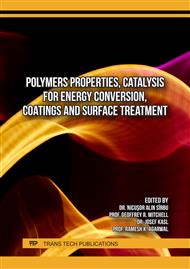[1]
W.G. Mao, J. Wan, C.Y. Dai, J. Ding, Y. Zhang, Y.C. Zhou, C. Lu, Evaluation of microhardness, fracture toughness and residual stress in a thermal barrier coating system: A modified Vickers indentation technique, in Surface and Coatings Technology, 2012, 206(21), p.p.4455–4461.
DOI: 10.1016/j.surfcoat.2012.02.060
Google Scholar
[2]
A. C. Fischer-Cripps. Introduction to Contact Mechanics. Springer Science, 2007, ISBN: 0-387-68187-6.
Google Scholar
[3]
D. Chicot, G. Duarte, A. Tricoteaux, B. Jorgowski, A. Leriche and J. Lesage. Vickers Indentation Fracture (VIF) modeling to analyze multi-cracking toughness of titania, alumina and zirconia plasma sprayed coatings, in: Materials Science and Engineering A 527.1-2 (2009), p.65–76.
DOI: 10.1016/j.msea.2009.08.058
Google Scholar
[4]
M.S. Lamana, A.G.M. Pukasiewicz, S. Sampath, Influence of cobalt content and HVOF deposition process on the cavitation erosion resistance of WC-Co coatings. Wear, 398-399 (2017), 209–219.
DOI: 10.1016/j.wear.2017.12.009
Google Scholar
[5]
P. Chivavibul, M. Watanabe, S. Kuroda, K. Shinoda, Effects of carbide size and Co content on the microstructure and mechanical properties of HVOF-sprayed WC–Co coatings. Surface and Coatings Technology, 2007, 202(3), 509–521.
DOI: 10.1016/j.surfcoat.2007.06.026
Google Scholar
[6]
G. Bolelli, L. M. Berger, M. Bonetti, L. Lusvarghi, Comparative study of the dry sliding wear behaviour of HVOF-sprayed WC-(W,Cr)2C-Ni and WC-CoCr hardmetal coatings. Wear, 2014, 309(1–2), 96–111.
DOI: 10.1016/j.wear.2013.11.001
Google Scholar
[7]
N.H. Faisal, R. Ahmed, A.K. Prathuru, S. Spence, M. Hossain, J. A. Steel, An improved Vickers indentation fracture toughness model to assess the quality of thermally sprayed coatings. Engineering Fracture Mechanics, 2014, 128, 189–204.
DOI: 10.1016/j.engfracmech.2014.07.015
Google Scholar
[8]
D. Chicot, P. Démarécaux, J. Lesage, Apparent interface toughness of substrate and coating couples from indentation tests, Thin Solid Films, 1996, Volume 283, Issues 1-2, Pages 151-157
DOI: 10.1016/0040-6090(96)08763-9
Google Scholar
[9]
D. Chicot, A. Tricoteaux, Mechanical Properties of Ceramic by Indentation: Principle and Applications. In Ceramic Materials (Wilfried Wunderlich). 2010.
Google Scholar
[10]
D. Chicot, H. Ageorges, M. Voda, G. Louis, M. A. Ben Dhia, C. C. Palacio, S. Kossman, Hardness of thermal sprayed coatings: Relevance of the scale of measurement. Surface and Coatings Technology, 2015, 268, 173–179.
DOI: 10.1016/j.surfcoat.2014.04.043
Google Scholar
[11]
J. Lesage, D. Chicot, Role of residual stresses on interface toughness of thermally sprayed coatings. Thin Solid Films, 2002, 415(1–2), 143–150.
DOI: 10.1016/s0040-6090(02)00488-1
Google Scholar
[12]
B.D. Beake, The influence of the H/E ratio on wear resistance of coating systems – Insights from small-scale testing. Surface and Coatings Technology, February, 2022.
DOI: 10.1016/j.surfcoat.2022.128272
Google Scholar
[13]
Š. Houdková, M. Kašparová, Experimental study of indentation fracture toughness in HVOF sprayed hardmetal coatings. Engineering Fracture Mechanics, 2013, 110, 468–476.
DOI: 10.1016/j.engfracmech.2013.05.001
Google Scholar
[14]
L.M. Berger, S. Conze, K. Gnauck, M. Vostřák, Š. Houdková, T. Taranda, Microstructure and Properties of Cr3C2-Rich Binary Cr3C2-WC-Ni(Co) Hardmetal Coatings. Proceedings of the ITSC 2023, Thermal Spray 2023, 2023, 589-596.
DOI: 10.31399/asm.cp.itsc2023p0589
Google Scholar


